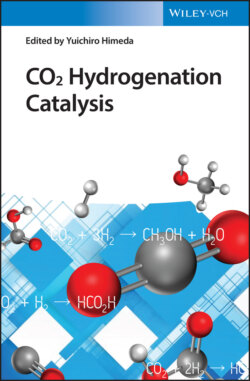CO2 Hydrogenation Catalysis

Реклама. ООО «ЛитРес», ИНН: 7719571260.
Оглавление
Группа авторов. CO2 Hydrogenation Catalysis
Table of Contents
List of Tables
List of Illustrations
Guide
Pages
CO2 Hydrogenation Catalysis
Preface
1 Introduction
1.1 Direct Use of CO2
1.2 Chemicals from CO2 as a Feedstock
1.3 Application and Market Studies of CO2 Hydrogenation Products
1.3.1 Formic Acid/Formate
1.3.2 Methanol
1.3.3 Methanation
1.3.4 Energy Storage
1.4 Supply of Materials
1.4.1 CO 2 Supply
1.4.2 Energy and H2 Supply
1.5 Political Aspect: Tax
1.6 Conclusion and Perspectives
References
2 Homogeneously Catalyzed CO2 Hydrogenation to Formic Acid/Formate by Using Precious Metal Catalysts
2.1 Introduction
2.2 Ir Complexes
2.2.1 Ir Complexes with N,N‐ligands. 2.2.1.1 Tautomerizable N,N‐ligands with OH Groups
2.2.1.2 N,N‐ligands with NH Group
2.2.1.3 Tautomerizable N,N‐ligands with OH and NH Groups
2.2.1.4 Tautomerizable N,N‐ligands with Amide Group
2.2.2 Ir Complexes with C,N‐ and C,C‐ligands
2.2.3 Ir Complexes with Pincer Ligands
2.3 Ru Complexes
2.3.1 Ru Complexes with Phosphorous Ligands
2.3.2 Ru Complexes with N,N‐ and N,O‐ligands
2.3.3 Ru Complexes with Pincer Ligands
2.4 Rh Complexes
2.5 Summary and Conclusions
References
3 Homogeneously Catalyzed CO2 Hydrogenation to Formic Acid/Formate with Non‐precious Metal Catalysts
3.1 Introduction
3.2 Iron‐Catalyzed CO2 Hydrogenation
3.2.1 Non‐pincer‐Type Iron Complexes
3.2.2 Pincer‐Type Iron Complexes
3.3 Cobalt‐Catalyzed CO2 Hydrogenation
3.4 Nickel‐Catalyzed CO2 Hydrogenation
3.5 Copper‐Catalyzed CO2 Hydrogenation
3.6 Manganese‐Catalyzed CO2 Hydrogenation
3.7 Other Non‐precious Metals for CO2 Functionalization
3.8 Conclusions and Perspectives
References
4 Catalytic Homogeneous Hydrogenation of CO2 to Methanol
4.1 Carbon Recycling and Methanol in the Early Twenty‐First Century
4.2 Heterogeneous Catalysis for CO2 to Methanol
4.3 Homogeneous Catalysis – An Alternative for CO2 to Methanol. 4.3.1 Benefits of Homogeneous Catalysis
4.3.2 CO 2 Hydrogenation to Methanol Through Different Routes
4.3.3 The First Homogeneous System for CO2 Reduction to Methanol
4.3.4 Indirect CO2 Hydrogenation
4.3.5 Direct CO2 Hydrogenation
4.3.5.1 Through Formate Esters
4.3.5.2 Through Oxazolidinone or Formamides
4.3.6 CO 2 to Methanol via Formic Acid Disproportionation
4.4 Conclusion
References
5 Theoretical Studies of Homogeneously Catalytic Hydrogenation of Carbon Dioxide and Bioinspired Computational Design of Base‐Metal Catalysts
5.1 Introduction
5.2 H 2 Activation and CO2 Insertion Mechanisms
5.2.1 Hydrogen Activation
5.2.2 Insertion of CO2
5.3 Hydrogenation of CO2 to Formic Acid/Formate. 5.3.1 Catalysts with Precious Metals
5.3.2 Catalysts with Non‐noble Metals
5.4 Hydrogenation of CO2 to Methanol
5.5 Summary and Conclusions
References
6 Heterogenized Catalyst for the Hydrogenation of CO2 to Formic Acid or Its Derivatives
6.1 Introduction
6.2 Molecular Catalysts Heterogenized on the Surface of Grafted Supports
6.3 Molecular Catalysts Heterogenized on Coordination Polymers
6.4 Molecular Catalysts Heterogenized on Porous Organic Polymers
6.5 Concluding Remarks and Future Directions
References
7 Design and Architecture of Nanostructured Heterogeneous Catalysts for CO2 Hydrogenation to Formic Acid/Formate
7.1 Introduction
7.2 Unsupported Bulk Metal Catalysts
7.3 Unsupported Metal Nanoparticle Catalysts
7.3.1 Metal Nanoparticles Without Stabilizers
7.3.2 Metal Nanoparticles Stabilized by Ionic Liquids
7.3.3 Metal Nanoparticles Stabilized by Reverse Micelles
7.4 Supported Metal Nanoparticle Catalysts
7.4.1 Metal Nanoparticles Supported on Carbon‐Based Materials
7.4.2 Metal Nanoparticles Supported on Nitrogen‐Doped Carbon
7.4.3 Metal Nanoparticles Supported on Al2O3
7.4.4 Metal Nanoparticles Supported on TiO2
7.4.5 Metal Nanoparticles Supported on Surface‐Functionalized Materials
7.5 Embedded Single‐Atom Catalysts
7.6 Summary and Conclusions
References
8 Heterogeneously Catalyzed CO2 Hydrogenation to Alcohols
8.1 Introduction
8.2 CO 2 Hydrogenation to Methanol – Past to Present. 8.2.1 Syngas to Methanol
8.2.2 CO 2 to Methanol
8.2.3 Thermodynamic Consideration – Chemical and Phase Equilibria
8.2.4 Catalyst Developments
8.2.5 Active Sites and Reaction Mechanisms: The Case of Cu/ZnO Catalysts
8.2.6 Beyond Industrial Cu/ZnO/Al2O3 Catalysts
8.3 CO 2 Hydrogenation to Ethanol and Higher Alcohols – Past to Present. 8.3.1 Background
8.3.2 Catalysts, Active Sites, and Reaction Mechanisms
8.3.2.1 Modified‐Methanol Synthesis Catalyst
8.3.2.2 Modified Fischer–Tropsch Catalysts
8.3.2.3 Rhodium‐Based Catalysts
8.3.2.4 Modified Molybdenum‐Based Catalysts
8.4 Summary
References
9 Homogeneous Electrocatalytic CO2 Hydrogenation
9.1 CO 2 Reduction to C─H Bond‐Containing Compounds: Formate or Formic Acid
9.1.1 Survey of Catalysts
9.1.1.1 Group 9 Metal Complexes
9.1.1.2 Group 8 Metal Complexes
9.1.1.3 Nickel Complexes
9.1.1.4 Iron and Iron/Molybdenum Clusters
9.1.2 Hydride Transfer Mechanisms in CO2 Reduction to Formate
9.1.2.1 Terminal Hydrides
9.1.2.2 Bridging Hydrides
9.1.3 Kinetic Factors in Catalyst Design
9.1.3.1 Roles of Metal–Ligand Cooperation
9.1.3.2 Roles of Multiple Metal–Metal Bonds
9.1.4 Thermochemical Considerations in Catalyst Design
9.1.4.1 Selectivity for Formate over H2 as a Function of Hydricity
9.1.4.2 Solvent Dependence of Hydricity
9.2 Prospects in Electrocatalysis: CO2 Reduction Beyond Formation of One C─H Bond
References
10 Recent Advances in Homogeneous Catalysts for Hydrogen Production from Formic Acid and Methanol
10.1 Introduction
10.2 Formic Acid Dehydrogenation
10.2.1 Organic Solvent Systems. 10.2.1.1 Ru
10.2.1.2 Ir
10.2.1.3 Fe
10.2.2 Aqueous Solution Systems. 10.2.2.1 Ru
10.2.2.2 Ir
10.3 Aqueous‐phase Methanol Dehydrogenation
10.3.1.1 Ir
10.3.1.2 Non‐precious Metals
10.4 Conclusion
References
Index
WILEY END USER LICENSE AGREEMENT
Отрывок из книги
Edited by
Yuichiro Himeda
.....
Yuichiro Himeda
National Institute of Advanced Industrial Science and Technology,
.....